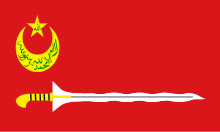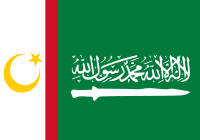Operation Darkhorse
| Operation Darkhorse | |||||||
|---|---|---|---|---|---|---|---|
| Part of the Moro conflict | |||||||
| |||||||
| Belligerents | |||||||
|
|
| ||||||
| Commanders and leaders | |||||||
|
|
| ||||||
| Units involved | |||||||
| Unknown | ||||||
| Casualties and losses | |||||||
|
1 killed 20 wounded[2] |
52 killed [3] 49 injured[3] 101 captured[2] | ||||||
| Civilians injured: 8[2] | |||||||
| Operation Darkhorse Oplan Dark Horse | |
|---|---|
| Part of the South Philippines insurgency | |
| Location | Maguindanao and North Cotabato Philippines |
| Target | Bangsamoro Islamic Freedom Fighters |
| Executed by | Armed Forces of the Philippines Philippine National Police Moro Islamic Liberation Front (support) |
Operation Darkhorse (Filipino: Oplan Darkhorse) was an offensive against the Bangsamoro Islamic Freedom Fighters (BIFF) launched by the Armed Forces of the Philippines on January 27, 2014.[2]
Background
The fighting broke just as the normalization annex of the Bangsamoro Framework Agreement was signed between the Philippine government and the Moro Islamic Liberation Front (MILF). Col. Dickson Hermoso, spokesman of the Army’s 6th Infantry Division, claimed that the offensive was not related to the signing of the annex of the peace treaty and said that the government has been collaborating with the MILF to launch an offensive against the BIFF even before the signing of the annex. The government offensive was part of an effort to arrest various BIFF leaders including its leader, Umbra Kato for various crimes. The Philippine National Police has issued a warrant of arrest for various BIFF leaders. Hermoso described the offensive as a "law enforcement" effort by government forces.[1]
The offensive is part of Joint Ad Hoc Joint Action Group, a joint effort by the Philippine government and the MILF to eliminate lawless elements from MILF communities.[4]
The offensive
January 28
Philippine military launched an artillery attack on BIFF targets with 105-mm howitzers. The military also conducted airstrikes. At least 20 BIFF members were killed according to the government. BIFF spokesperson, Abu Misry Mama denied that there were casualties on their side.[5]
January 29
BIFF spokesman, Abu Misry Mama said that the BIFF is open for negotiations with the government. He said that the BIFF is disappointed with the treatment of the government of their group. He said that the government keeps sending heavily-armed forces to their communities on which he said forces the BIFF to retaliate. The BIFF wants a "straight to the point" and "direct" peace negotiation compared to the negotiations between the Philippine Government and the MILF, according to the spokesman. Mama added that the BIFF longs for an independent state where everyone is equal. Col Dickson Hermoso, spokesman of the 6th Infantry Division, turned down the BIFF's request for negotiations and said that the BIFF must first face criminal charges against them.
January 31
Lt. Col. Ramon Zagala, Armed Forces public affairs office chief said that government forces has seized at least five strategic BIFF camps. He identified the following locations; the headquarters in Barangay Dasawao, Shariff Saydona Mustapha, a training facility in Barangay Ganta, Shariff Saydona Mustapha, an improvised explosive device factory in Barangay Ganta, Shariff Saydona Mustapha and advance posts in Barangay Bakat, Shariff Saydona Mustapha and Barangay Damablas in Datu Piang. The casualties according to government forces includes 53 BIFF fighters, including 3 child soldiers and one soldier from the Philippine government side. The BIFF continues to deny that there were casualties on their side.[6]
February 1
The government planned to end the offensive on February 1, the second deadline set by the Joint Ad Hoc Joint Action Group. BIFF spokesman Abu Misry Mama said that they captured and torched an armored personnel carrier (APC). The spokesman said that they can't utilize the vehicle due to the lack of roads in their area so they decided to torch the vehicle after removing the 50-caliber machine gun attached to the vehicle
Government forces captured the main stronghold of the BIFF in Barangay Ganta, Shariff Saydona Mustapha. The flag of the Philippines was raised at the former BIFF camp. [2]
February 2
The Armed Forces of the Philippines formally ended Operation Darkhorse. Col. Dickson Hermoso, 6th Infantry Division spokesman, claimed that the government forces has significantly lowered the morale of BIFF fighters following the capture of at least four strategic BIFF camps. The military declared that civilians displaced due to the operation may now return to their homes. [2] The military added that their law enforcement operations will continue despite the formal conclusion of Operation Darkhorse. [7]
There is no official confirmation that Ameril Umbra Kato, leader of the BIFF was killed or captured during the military operation.[7]
Humanitarian concerns
9,465 families or 35,334 people were displaced due to the clashes, with most of them coming from Shariff Saydona Mustapha, Rajah Buayan, Datu Piang in Maguindanao and Pikit in North Cotabato. Some areas where the displaced persons may need to be rehabilitated. The military has vowed "speedy reconstruction" of affected areas after the conclusion of the military offensive.[3][8]
It was also reported that three child soldiers of the BIFF were killed during the operations. The Philippine government condemned the reported use of child soldiers by the BIFF as a violation of human rights.[3]
References
- 1 2 3 4 "AFP raids BIFF lairs". Retrieved 5 September 2016.
- 1 2 3 4 5 6 AFP ends offensive with fall of BIFF main lair | Manila Bulletin | Latest Breaking News | News Philippines
- 1 2 3 4 "Military declares end of offensive vs BIFF". Retrieved 5 September 2016.
- ↑ Dizon, Nikko. "AFP operations vs BIFF in Maguindanao extended until Saturday". Retrieved 5 September 2016.
- ↑ "Military continues ops vs. BIFF in Maguindanao". Retrieved 5 September 2016.
- ↑ "Child soldiers among 53 dead in Maguindanao clashes — military". Retrieved 5 September 2016.
- 1 2 "AFP focusing on neutralizing BIFF’s IED-making capability | News | GMA News Online". www.gmanetwork.com.
- ↑ "Philippine military lauds success against Muslim rebels - World News - SINA English". Retrieved 5 September 2016.

